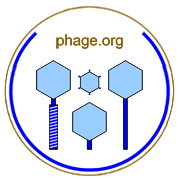

Phage population growth within a spatially constrained environment, particular agar-containing media, and which typically involves sufficient local depletion of bacteria that a visible clearing is observed against an otherwise turbid bacterial
lawn.
Plaques can be initiation by individual phages, phage-infected bacteria, and even arrangements or clumps of such bacteria, which generally are described as infective centers. The development of a plaque is a relatively complex process involving multiple rounds of phage diffusion, adsorption, infection, and lysis.
Only if diffusion is fast enough, adsorption sufficiently likely, infections reasonably productive (burst size), and lysis relatively rapid may plaques become visible to the eye. As a consequence, an absence of plaque formation should not be equated with lack of phage viability. Contrast, for example, efficiency of plating with efficiency of center of infection.
Note that lytic phages are not the only entities that can produce a clearing on a bacterial lawn. Others include chronically infected bacteria, carnivorous bacteria (e.g., Bdellovibrio), and even antibiotic-producing bacteria.
For references and discussion, see Abedon and Yin (2008), Abedon and Yin (2009), Abedon (2010), and Abedon (2011). For discussion of modeling plaque formation, see Culler and Abedon (2007) and Krone and Abedon (2008).
For more on this topic, see Wikipedia, Google, and PubMed. Contact web master. Return to terms.